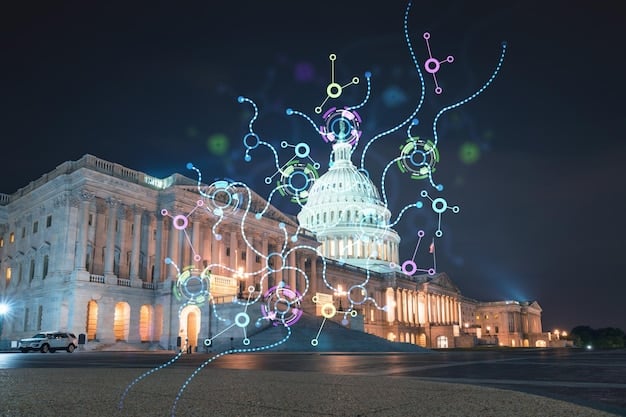Blockchain Governance Models: Decentralized Impact on US Projects

Blockchain Governance Models: How Decentralized Decision-Making Impacts US Blockchain Projects examines various governance structures, highlighting their influence on the efficiency, security, and regulatory compliance of blockchain initiatives within the United States.
The rise of blockchain technology has brought forth innovative solutions across various sectors, but the backbone of any successful blockchain project lies in its governance model. Blockchain Governance Models: How Decentralized Decision-Making Impacts US Blockchain Projects delves into the intricacies of these models, exploring how decentralized decision-making shapes the landscape of blockchain initiatives within the United States, ensuring they remain robust, secure, and compliant.
Understanding Blockchain Governance Models
Blockchain governance models define the rules, processes, and decision-making structures that guide the evolution and operation of a blockchain network. These models are crucial for addressing issues like protocol upgrades, dispute resolution, and network security, directly affecting the project’s overall efficacy and sustainability.
Centralized vs. Decentralized Governance
Governance in blockchain can range from centralized, where a single entity or a small group controls decision-making, to fully decentralized, where decisions are made collectively by the network participants. Each approach has its advantages and challenges, depending on the project’s goals and community structure.
Key Elements of Governance
Effective blockchain governance involves several key elements, including transparent communication, community participation, clearly defined roles and responsibilities, and mechanisms for proposing and implementing changes.
- Transparency: Open and accessible information about decisions and processes.
- Community Participation: Active involvement of network participants in governance.
- Defined Roles: Clear assignment of responsibilities and decision-making authority.
- Change Mechanisms: Protocols for proposing, voting on, and implementing network changes.
Ultimately, the choice of a governance model dramatically influences how blockchain projects operate and adapt to changing environments. The more these projects empower their user base to take part in the decision-making process, the more resilient and innovative their governance will be.

Impact of Decentralized Decision-Making
Decentralized decision-making is a cornerstone of blockchain governance, enabling a network to distribute power and authority among its participants. This approach fosters greater inclusivity and resilience but also presents unique challenges.
Benefits of Decentralization
Decentralization can lead to increased security, as there is no single point of failure. It also encourages innovation, as diverse perspectives can contribute to decision-making. Additionally, decentralization enhances trust, as decisions are made collectively and transparently.
Challenges of Decentralization
However, decentralization also poses challenges, such as slower decision-making due to the need for consensus. Coordination among a large number of participants can be complex, and ensuring accountability can be difficult in a decentralized environment.
Finding the right balance between decentralization and efficiency is crucial. A successful model will harness the benefits of decentralization while mitigating its potential drawbacks.
- Security: Enhanced protection against single points of failure.
- Innovation: Diverse perspectives driving creative solutions.
- Trust: Increased confidence through transparent decision-making.
In conclusion, decentralized decision-making is a powerful tool for blockchain governance, but its effectiveness depends on how well it is implemented and managed.
Blockchain Governance in the US Legal Framework
Blockchain projects in the United States operate within a complex legal and regulatory landscape. Understanding these regulations is crucial for ensuring compliance and long-term sustainability.
Navigating US Regulations
US regulations concerning blockchain and cryptocurrencies are evolving, with different states and federal agencies taking varying approaches. Issues such as securities laws, money transmission regulations, and data privacy requirements all affect blockchain projects.
Regulatory Compliance
Projects must navigate these regulations carefully, seeking legal advice and implementing compliance measures to avoid penalties and maintain their operational viability.
Blockchain projects across all scales are impacted by federal and state regulations. Understanding compliance concerns prevents not only regulatory infractions, but also financial losses stemming from unexpected penalties.

Real-World Examples of Governance Models
Examining real-world examples of blockchain governance models provides valuable insights into their practical application and effectiveness. Various projects have adopted different models, each with its own strengths and weaknesses.
Bitcoin
Bitcoin’s governance is based on a decentralized, open-source model, where changes to the protocol require consensus among a majority of the network’s nodes. The decentralized nature of Bitcoin has been instrumental in its long-term stability, as it prevents any single entity from controlling the network.
Ethereum
Ethereum utilizes a more centralized approach compared to Bitcoin, with the Ethereum Foundation playing a prominent role in guiding development and implementing protocol upgrades. While this can allow for faster decision-making, it also raises concerns about potential centralization.
Ethereum’s model is more centralized, enabling quicker decisions with certain centralization concerns. These examples are invaluable in demonstrating the pragmatic impacts of blockchain governance models, as well as highlighting potential strengths and shortcomings.
- The Bitcoin Blockchain: Stability due to decentralization.
- The Ethereum Blockchain: Potential risks of centralized systems.
These real-world examples demonstrate the diversity and adaptability of blockchain governance models across distinct projects in the cryptocurrency arena.
The Future of Blockchain Governance
The future of blockchain governance is likely to involve greater experimentation with decentralized autonomous organizations (DAOs) and other innovative models. As blockchain technology matures, governance will become increasingly important for ensuring its long-term success.
Decentralized Autonomous Organizations (DAOs)
DAOs are emerging as a promising governance mechanism, enabling automated and transparent decision-making through smart contracts. DAOs can facilitate community-driven governance, where participants vote on proposals and allocate resources.
Hybrid Models
Hybrid models that combine elements of centralized and decentralized governance may also gain prominence, allowing projects to leverage the strengths of both approaches while mitigating their weaknesses. Hybrid models can offer a balance between efficiency and community involvement.
The next generation of governance will incorporate new innovations such as DAOs and hybrid models incorporating elements of centralization and decentralization, leveraging the advantages of both mechanisms.
Comparing Governance Models: A Detailed Analysis
Comparing different governance models involves evaluating their various aspects, including decision-making speed, transparency, security, and community involvement for US Blockchain Projects.
Decision-Making Speed
Centralized models typically allow for faster decision-making, as a single entity or a small group can make decisions quickly. Decentralized models, on the other hand, require consensus among a larger group, which can slow down the decision-making process.
Transparency and Security
Decentralized models often offer greater transparency, as decisions are made publicly and recorded on the blockchain. In terms of security, decentralization reduces the risk of single points of failure. Each model possesses its drawbacks and advantages in the governance of US Blockchain Projects.
| Aspect | Centralized Governance | Decentralized Governance |
|---|---|---|
| Decision-Making Speed | Faster | Slower |
| Transparency | Lower | Higher |
| Security | Lower | Higher |
| Community Involvement | Lower | Higher |
The choice of governance model depends on the project’s specific needs. By systematically assessing factors such as decision-making speed, degree of transparency, security protocols, and involvement within the community (US blockchain projects), better decisions can be made.
| Key Aspect | Brief Description |
|---|---|
| 🛡️ Security | Decentralized governance enhances protection against single points of failure. |
| 💡 Innovation | Diverse perspectives in decentralized models drive more creative solutions. |
| 🏛️ Regulation | US Blockchain projects must adhere to evolving state and federal laws. |
| 🤝 Community | Community-driven models promote transparent, inclusive governance. |
Frequently Asked Questions (FAQ)
Blockchain governance models outline the rules and processes for making decisions about blockchain network modifications and operations.
Decentralized decision-making enhances security and inclusivity, however it can also slow down decision processes. It promotes widespread participation, innovation, and resilience.
Challenges include slower decision-making, coordination complexities, accountability concerns, and balancing decentralization with efficiency in governance.
DAOs offer automated, transparent decision automation and community-driven governance. They facilitate widespread voter participation and resource allocation using smart contracts.
Legal support can be obtained from law firms specializing in blockchain technology and cryptocurrency regulations to ensure compliance and avoid penalties.
Conclusion
In conclusion, understanding blockchain governance models is crucial for the success and sustainability of blockchain projects in the US. As the technology matures, governance will play an increasingly important role in shaping its future, ensuring it remains secure, compliant, and aligned with the needs of its users.





